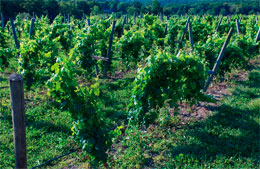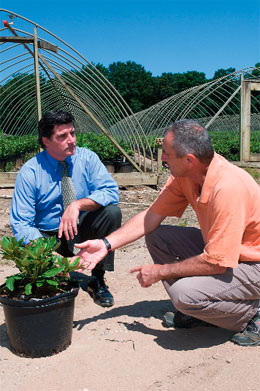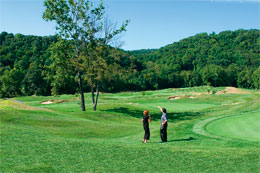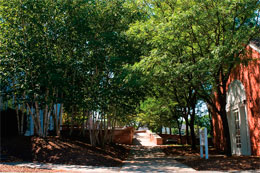|
Marketing
Protecting clients' live assets
New program covers the substantial values of trees, shrubs and plants
By Edward O'Hare
The JLS Group, Inc., a 100-year-old risk management consulting and insurance brokerage firm based in New York City, has formed a Live Asset Insurance Division to cover a wide range of valuable green inventory. The division is promoting an ambitious national program to insure trees, shrubs, grapevines and flowers at commercial enterprises such as golf courses, vineyards, office parks, educational facilities, nurseries, tree farms, botanical gardens, cemeteries and resorts. Agents and brokers in 19 states currently can access the program.
“Natural disasters and changing weather patterns have accelerated the need for a private insurance product that could properly insure live assets affected by these events,” says David J. Teed, CIC, managing director of the program. “The government’s crop insurance program was the only source for significant live asset coverage until now.”
Says Teed, “When it comes to private insurance, it’s an untapped market. I was reading an accounting report that suggested live assets should be treated as other valuable tangible assets on the balance sheet.” For JLS, it presented the potential for a whole new line of insurance.
Their goal became to design and market a veritable “life insurance policy” that would provide the extensive (up to $10 million) coverage for live assets not available in standard commercial policies. JLS intends to make the Live Asset Insurance program the main source for living plant material coverage countrywide.
“Never before,” says Teed, “has the commercial marketplace covered trees, shrubs, grapevines or flowers on a named perils replacement cost basis, with limits up to $10 million per location.”
To make it happen, JLS first had to convince skeptical insurance underwriters that live assets could be assigned values, and their condition could be monitored. They accomplished this task by developing a working arrangement with Horticultural Asset Management, Inc., (HMI) of Cary, North Carolina (www.moneygrowsontrees.com), which has a database of some 750,000 wholesale prices that enables it to validate the pricing of plant materials covered by Live Asset Insurance.
“We provide evaluations, inspections and remedial services through a national network of arborists,” says Doug Cowles, HMI president and CEO. “Not only can we tell today’s value of trees and shrubs, but what their value will be five years from now. These assessments assist agents and brokers in providing the proper level of insurance for their clients, particularly in determining replacement costs.”
In making the case for Live Asset Insurance, Cowles notes that trees and shrubs provide more than an aesthetic value to any property. “They are costly to acquire, and replacing them is even more expensive as they increase in size. Even an average size tree can cost $20,000 or more. A prized giant oak might be worth as much as $100,000.”
With the underwriters’ concerns satisfied through the HMI connection, JLS launched their program in 19 states in July 2008, with the backing of a major A-rated insurance carrier. Live Asset Insurance focuses on the commercial marketplace, but it will also write residential estates.
Along with its $10 million limits, the policy covers debris removal, the cost of new replacement plant material and the expense to replant the destroyed material. It requires a $5,000 minimum premium and carries a $10,000 minimum deductible.
“With up to 10% commission available, selling live asset insurance,” says Teed, “can generate substantial profits for agents and brokers,” many of whom, he believes, already have clients on their books that will benefit from this coverage. He notes that none of the insurance carriers offers any significant coverage for the replacement of destroyed landscape materials held for sale or already planted in the ground.
“This has created a unique opportunity for Live Asset Insurance to be utilized in hundreds of commercial applications across the country. Working with fellow agents and brokers was something JLS was insistent on when setting up the program,” he explains.
“Some clients are currently insuring live assets as ‘contents’ under their commercial insurance policies,” Teed continues. “Our coverage and costs will easily stack up against any product priced this way. If you are an insurance professional who properly blends coverage and cost for your clients, this policy will assist you in your efforts, as well as provide a proactive tool for targeting new clients.”
Live Asset Insurance is aiming to be an Internet-based program. “As the product is new in the market, most brokers are not yet aware of its existence. We are initially promoting the product exclusively through our Web site in the 19 states where we are currently operating. Our goal is to be in all 48 contiguous states by the end of 2009 and to be a fully integrated online insurance source.”
JLS acknowledges that ANLA, the American Nursery and Landscape Association, has “enthusiastically endorsed our new product,” and played an active role in shaping the final coverage language for its members. Wildfires, flooding, freeze and other acute natural disasters throughout the country have dramatically affected growers of all sizes and have made the introduction of this new Live Asset Insurance Policy very timely for the entire green industry. Nursery and floriculture crops rank third in total plant crop revenues at the farm gate (behind corn and soybeans), according to the ANLA.
Agents and brokers also have given an enthusiastic endorsement of the program and its “much-needed” expansive coverage for plant materials.
Kathy Bodungen of Traditions Insurance Services, Inc., El Campo, Texas, offers these comments: “Live Asset Insurance is the solution that we’ve been waiting for years to sell to our valued clients. It is an affordable insurance program that can add additional coverage to the government-backed nursery crop insurance or any business insurance, or it can be used alone. We especially appreciate the fact that there is no restrictive plant list—all nursery-growing inventory is insurable at replacement cost value.
“Our clients with very large container-grown trees can finally insure their product at a true replacement value—not the undervalued price mandated by FCIC. Perils such as theft and vandalism are also covered.”
Bodungen concludes: “The policy can be customized to include trees in transit or used as a warrantee for plant material against lightning, freeze, hail, fire, theft and other perils on large landscape installations. Also important is the fact that the carrier for Live Asset Insurance is an A-rated entity.”
Lonna F. Mackay of The Dougherty Company, Signal Hill, California, recounts this experience with JLS and Live Asset Insurance. “I have a client that operates a nursery with a lot of exotic and expensive plants, trees and shrubs, used for movie sets and at many of the nicer hotels in Las Vegas. The insured had no coverage and I couldn’t find any until I went on the Internet to locate a market that specializes in plants, trees and shrubs and found information on this new program.
“I discussed my circumstances with David Teed, and he said it shouldn’t be a problem,” Mackay continues. “You can typically insure between $500,000 and $1 million of plant inventory for the minimum premium of $5,000 depending on the deductible chosen and location.”
Mackay also likes the program’s requirement for a plant inventory. “When my client completed their plant inventory, they learned that they were drastically underinsured. We increased the limit to wholesale replacement cost which generated an additional premium. Live Asset Insurance was able to finance the additional premium with a very low interest rate so my insured can make payments.”
Mackay sums up her experience this way. “They are very easy to work with and issue quotes quickly. I highly recommend them to protect clients that have any live asset exposures.”
Jack F. Puckett of Capstone Insurance Services, Greenville, South Carolina, has this to say: “Prior to our discovery of this program, we were unable to locate an insurance carrier to provide inventory coverage at an affordable price and with a reasonable retention. The federal crop program was and remains available but, even at its lowest coverage attachment points, it leaves the customer with a considerable retention.
“As the percentage retention is brought down through the federal crop program, premiums become very expensive. Given the cost to transfer the excess levels of risk, our customers have decided not to buy down their federal crop program deductibles and have survived with true catastrophe coverage that left them retaining as much as half of their inventory as uninsured.
“The Live Asset Insurance program provides inventory coverage with potentially low deductibles, such as $10,000 for one customer with inventory values in the $10 million range. The policy insures against named perils including a surprisingly broad list of exposures.”
Puckett concludes with this observation of the program. “It has been my experience that our industry is very good at enhancing existent products, but seldom do we launch brand new products to solve previously unresolved problems.”
Along with agents and brokers, Teed says, “Lenders, accountants and lawyers should all be aware of this coverage. Lenders, in particular, should view live assets like other fixed or tangible assets, such as buildings, inventory or business personal property and explore being listed as loss payees on their Live Asset loans subject to natural disaster perils.”
According to Teed, Live Asset Insurance will also place agents and brokers on the right side of the environmental movement, which has people “greening” their buildings and surroundings, a trend that will continue to raise the awareness level of live assets and the need for their proper insurance.
Through Live Asset Insurance, agents and brokers can contribute to the environmental effort, while at the same time benefit from the fact that in this program, money really does “grow on trees.”
For more information:
JLS Group, Inc.
Live Asset Insurance Division
Web site: www.liveassetinsurance.com |
|
| |
 |
| |
The Pebble Ridge Vineyards & Wine Estates in Millbrook, New York. |
| |
 |
| |
David J. Teed, CIC, Managing Director of the Live Asset Insurance Division of JLS Group, Inc. (left), discusses plant inventory with Karl J. Novak, General Manager of Connecticut Operations for Imperial Nurseries. |
| |
 |
| |
David Teed and Iris Hulse, Membership Director of the Hollow Brook Golf Club in Cortlandt Manor, New York, look over insured property. |
| |
 |
| |
JLS Group insures the "live assets" of Suffield Academy in Suffield, Connecticut. |
| |
"Our clients with very large container-grown trees can finally insure at a true replacement value."
—Kathy Bodungen
Traditions Insurance Services,Inc.
El Campo, Texas |
| |
| |
| |
“Never before has the commercial marketplace covered trees, shrubs, grapevines or flowers on a named perils replacement cost basis, with limits up to $10 million per location.”
—David J. Teed |
| |
|
|